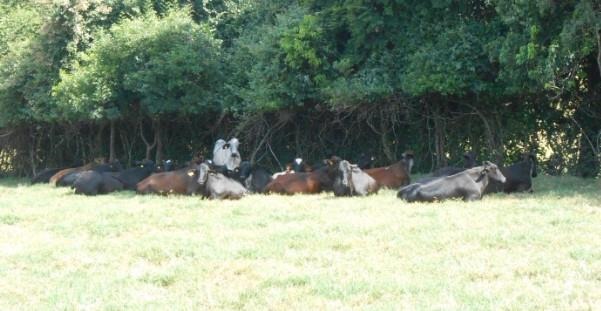By Michelle Leinfelder-Miles
I have visited a few fields - and have spoken on the phone about a few more - where the alfalfa has been slow to start growing this spring. Based on my observations, and some feedback from colleagues, we came up with the following thoughts on why this might be happening.

Figure 1. Slow spring growth in a local alfalfa field. The photo was taken in mid-March.
It feels like we were cheated out of our rainy season since we beat dry records for the months since January. October through December seem like the distant past, but those were wet months! (Depending on location, over 5 inches fell in late October, and over 7 inches in late December.) On fine textured and/or low permeability soils, the high amount of rainfall that fell in short windows of time may have impacted alfalfa roots. In one field that I visited (Figure 1), notice how the borders are greener, and I suspect, better drained. We dug up plants from this field, and the taproots looked pretty healthy. There were no obvious signs of root rot, but there were almost no fine roots coming off the taproots (Figure 2). The fine roots are where we would expect to see root nodules, and without root nodules, the plant will not fix nitrogen the way it should. This can cause lower nitrogen availability for the crop and reduce growth. While we generally do not recommend applying nitrogen to alfalfa fields, there are a few rare situations where it may be beneficial, as noted in this article by Farm Advisor Rachael Long. A field with poor nodulation may be one situation where starter N (11-52-0) can help to regrow roots and reestablish nodulation.

Figure 2. Healthy alfalfa taproots but few feeder roots.
Because of the wet conditions, winter herbicide sprays were delayed into mid- to late January, and even early February. On top of that, temperatures were fairly mild this winter, and many alfalfa fields continued growing. Early February is a bit late for applying herbicides. Even mid- to late January is not ideal, particularly if early April is targeted for the first cutting. Some burn-down herbicides are pretty ‘hot', especially at the high label rate, so it's important to spray early enough that the alfalfa has time to regrow. Some fields still looked pretty burned in mid-March, especially where there was a lot of growth at the time of spraying. I have observed, however, that new stems were emerging from the crown (Figure 3), at least in the fields I visited. So, my hunch is that the fields will snap out of this, but probably not in time for an early April cutting.

Figure 3. Stems emerging indicate the crown is not damaged and alfalfa will regrow.
Of course, there are some areas in our region where stem nematode can be a problem. Stem nematode is fairly easy to diagnose, but unfortunately, it is not an easy problem to solve. Resistant varieties and equipment sanitation are the primary ways of minimizing damage. Luckily, when soils warm, the nematodes recede deeper into the soil and have less impact.
As I was writing this article, I came to realize that I wrote an article a few years ago with this same title. The reasons for slow spring growth in 2019, however, were a bit different from the reasons in 2022. So, it would seem that no two years are ever the same.
Please reach out if you would like to discuss this information further, and good luck this season!
Source : ucanr.edu